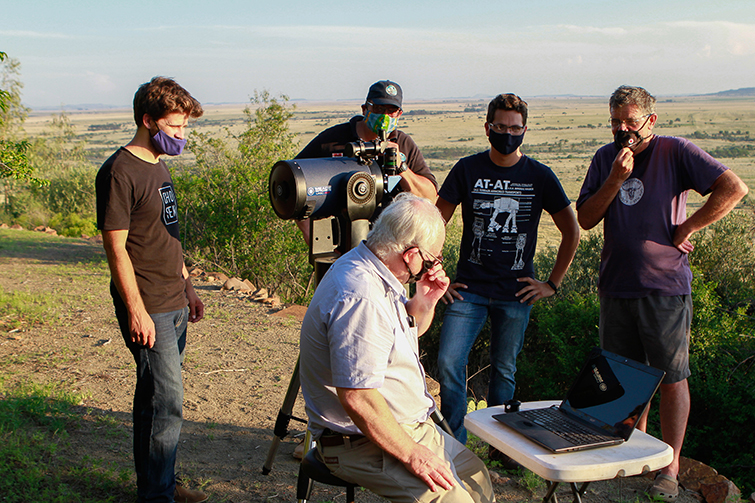28 January 2021
|
Story Igno van Niekerk
|
Photo Supplied
 Pictured from the left: Lucas Erasmus from the Department of Physics, Piet le Roux from the Astronomical Society of SA – Bloemfontein, Quinton Kaplan from the Department of Physics, Thinus van der Merwe from the Astronomical Society of SA – Bloemfontein. Front: Prof Matie Hoffman
Pictured from the left: Lucas Erasmus from the Department of Physics, Piet le Roux from the Astronomical Society of SA – Bloemfontein, Quinton Kaplan from the Department of Physics, Thinus van der Merwe from the Astronomical Society of SA – Bloemfontein. Front: Prof Matie Hoffman
In his book, The World is Flat, Thomas Friedman mentions how at first countries, then companies, and eventually communities went global. In true flat-world fashion, a combined team of the University of the Free State (UFS) and the Astronomical Society of South Africa – led by Prof Matie Hoffman, Associate Professor in the
Department of Physics – participated in a once-in-a-lifetime event with their counterparts from the Ellinogermaniki Agogi School and the Skinakas Observatory in Greece.
On 21 December 2020, Earth was treated to the Jupiter-Saturn conjunction, when the two planets were only 0.1 degrees apart in the sky. Although conjunctions are regular phenomena, NASA mentions that the great conjunction of Jupiter and Saturn in 2020 was the closest since 1623 and the closest observable since 1226! A pinkie finger at arm’s length could cover both planets – although they were still millions of kilometres apart in space.
Planning started months ahead of the event, with the Ellinogermaniki Agogi Observatory in Greece and the
Boyden Observatory in Bloemfontein chosen as the two selected vantage points. From both the Southern and Northern Hemisphere, the conjunction would be broadcast live on YouTube. As with any other technical project on an international scale, challenges arose. For example, in the Northern Hemisphere, it was already dark at 17:45 while the South African astronomers were still basking in sunlight until after 19:00. The conjunction would only be visible from South Africa after 19:30, almost two hours after it would be visible in Athens. The time was well used, with the event including a word of welcome by the Consul General of Greece in South Africa, Ioannis Chatzantonakis, presentations on Saturn and Jupiter, as well as a virtual tour of the Boyden Observatory, emphasising its connection with Greece through its first Director, Stefanos Paraskevopoulos.
On Saturday, 19 December, the teams ‘gathered’ on opposite sides of planet Earth to do a dry run. One could sense the urgency and tension as both teams realised that they would have a huge captive audience on YouTube, and plans had to be made in case of connectivity challenges and if the weather did not allow the conjunction. As preparations progressed, Prof Hoffman was talking to his Greek counterparts and was simultaneously walking around with his laptop to share the landscape and activities via his webcam with colleagues in Greece.
Monday 21 December 2020 – the weather prediction was correct. Clouds covered the Free State sky and scattered raindrops started to fall. Revert to Plan B. A recording made on Saturday evening was shared via the YouTube link, while a live feed of the conjunction from elsewhere in South Africa was arranged. From both sides of the world, information was shared about the history of the venues, as well as the marvel of what was happening in space. Fortunately, expert planetary photographer Clyde Foster was able to share a live feed just after 19:30 from the observatory at his home in Centurion, Gauteng. Those attending the event where visuals and speakers were together on one screen – yet thousands of kilometres apart – watching an event in outer space, will indeed agree with Thomas Friedman: the world is flat. The live-stream event of the conjunction was a catalyst that will result in continued collaboration between the UFS and colleagues in Greece in the field of astronomy.
By the time of this writing, the livestream has reached more than 50 000 people.